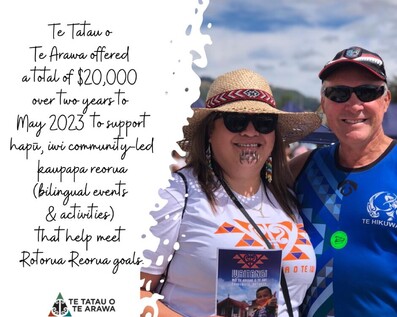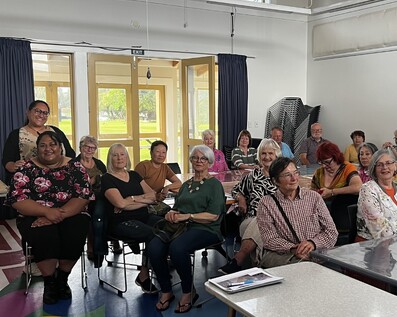TO TĀTAU WAIMARIE HOKI!
E waimarie katoa ana mātau i Rotorua nei i te nui o ngā āheinga ki te ako i te reo Māori – kanohi ki te kanohi, mā te ipurangi, mā ngā taupānga rānei – Kai a koe te tikanga!
Mēnā koe ka whakaako karaehe reo Māori i Rotorua nei, tēnā, whakamōhio mai ka tāpirihia ai tō akomanga ki tā mātau rārangi!
<<<>>>
We are very lucky in Rotorua to have a myriad of options for learning te reo Māori – in person online or through apps – You choose what’s right for you!
If you provide te reo Māori classes in Rotorua, please feel free to let us know and we can include you in our list!

Papa kupu
Akomanga ā-kanohi ki te kanohi | On location classes
Kōtihi Reo Consultants
Toi-Ohomai
Tikanga Aroaro (based in Rotorua)
Te Wānanga o Aotearoa (locations nationwide)
Te Ataarangi (locations nationwide)
Akomanga ā-ipurangi | Online courses

Ki hea tīmata ai? | Where to start?
Koia kai a koe! Kua tīmata tō whakaemi i te kaupapa Rotorua Reorua. Ehara i te mea me kawe koe i tō pakihi i te reo Māori…i tēnei wā. E taea ana te reo Māori te whakamahi i te ao pakihi hai whakaaro atawhai ki te reo me te taiao tāone reorua nei, hai rautaki tauhokohoko e aro ana ki ngā kiritaki kōrero Māori.
Kua whakawhanakehia e mātau ētehi taumata hai eke māu nōu e tīmata nei i tēnei haerenga ōu.
<<<>>>
Koia kei a koe! (good on you!), you have made the first step towards embracing Rotorua Reorua. No one is expecting you to conduct your business in te reo…yet. Te reo Māori can be used in business to show courtesy to our language and our bilingual city environment and as a marketing tool to recognise speaking customers.
We have developed a series of small steps to help you get started on this journey.
1 – Ngā whāinga me ngā wawata
Ko tētehi huarahi ki te whakauru i te reo Māori ki tō tōpūtanga he mōhio ki ō whāinga me ō wawata ka āta haere ai ki te whakatutuki i a rātāu ā te wā.

2 – Ngā pukapuka
Tuatahi, tautohua te wāhi e taea nā e koe te reo Māori te whakauru, ā, whakawhanakehia te reoruatanga i reira. Hai whakatauira ake, tērā pea ko tāu he whakareorua i ō pukapuka, ā, ina tāngia ana e te kamupene ngā pukapuka hou kua rite kē te whakatakotoranga Reorua hou hai tā mā rātau.
Kai Te Taura Whiri i te Reo Māori ētehi kaupapa ārahi tuhinga hai whakamahi māu i konei.


3 – Ngā tohu
E mōhio ana tātau ki te painga o ngā tohu (ō-roto, ō-waho hoki) ki te whakatairanga i te kaupapa o tō tōpūtanga, ka mutu, hai whakaratarata kiritaki ki tō tōpūtanga.
Ehara i te mea mā te tohu reorua e whakaitingia ai te kaupapa, te waitohu rānei, ko tāna kē he whakarākai, he hiki hoki i te kaupapa.
Whakapuakina ngā mihi Māori pēnei i te “Kia ora” me te “Ngā mihi”.
Reoruatia ētehi tohu ō-roto (ērā kua tāngia ā-tara-ā-wharetia ai) – pērā i:
4 – Ngā mea whakatairanga
Nōu e hoahoa anō ana, e tārua anō ana rānei i ngā mātārere, i ngā kāri pakihi – otirā, i ngā mea katoa e whakamahi nā koe ki te whakatairanga i tō pakihi ki ō kiritaki mohoa me ō kiritaki hou hoki. Tēnā, tonoa tō kaihoahoa, tō kaitā rānei ki te whakauru i te reo Māori ki te tauira.
Mēnā karekau i nui te wāhi wātea, reoruatia ngā upoko me ētehi kīanga Māori i roto atu i te mātārere. Ki te hiahia koe kia whakamīharotia, tēnā, me whakaaro kia whakaputaina reoruatia ō mea katoa.
E tūtohu ana mātau ki a koe kia tonoa ngā kaiwhakamāori māraurau e mātua mōhio ai kai te tika, kai te rite tonu hoki te reo Māori. Anei rā tētehi rārangi kaiwhakamāori māraurau me ā rātau taipitopito whakapā. Kia mataara hoki koe ki ngā tūreo o tēnā rohe, o tēnā iwi me ngā rerekētanga, ā, ko Te Arawa hoki tērā. Koia hoki te take e tūtohu ana mātau ki a koe kia kimihia ngā kaiwhakamāori kua tohua ō rātau hononga ki Te Arawa.

5 – Pae tukutuku
Whakamenomenotia tō tōpūtanga Reorua i te ipurangi! Mēnā rānei he paetukutuku reorua katoa, mēnā rānei ka whakaurua noatia te reo Māori ki ngā upoko me ngā tuhinga, ko tā mātau tūtohu atu kia kitea ngā reo e rua i te nuinga o ngā whārangi e mārama ai ki te kaitirotiro, e pānui nei i te reo Pākehā, te reoruatanga.
6 – Kaikōrero reo Māori
Mēnā kua waimarie koe i ngā kaikōrero reo Māori i tō tōpūtanga, whakamōhiotia ō kiritaki!
Mēnā e taunga ana te hunga reo Māori o tō tōpūtanga ki te kōrero i te reo Māori nō rātau e mahi ana (whakapā atu i te tuatahi), he tino taonga rātau, ka mutu, kua hiahia pea koe ki te whakanui i a rātau i tēnei tino pūkenga.
He reka ki te ngākau Māori mēnā i a ia te āheinga ki te mahi i āna mahi i te reo Māori, engari me mātua mōhio ia ki te hunga kōrero Māori.
He pai pea kia kitea t/ētehi whakaahua o t/ō kaimahi reo Māori, arā hoki kai Te Puni Kōkiri te maha o ngā pine KŌRERO e wātea ana ki a koe, kai tō rātau tari i te tiriti o Haupapa hai whakamahi mā koutou ki te whakaatu ko wai mā e taunga ana ki te kōrero i te reo Māori.
1 – Ngā wawata | Goals and aspirations
A simple way to incorporate te reo Māori into your organisation is to identify your goals and aspirations and slowly work towards achieving them over time.
2 – Ngā pukapuka | Stationery and documents
Start by identifying one area where you can incorporate te reo Māori and develop bilingualism from there. For example you could decide on a bilingual format for your stationery and when the company is printing new stationery in the next print run they can use the Reorua format.
Te Taura Whiri i te reo Māori has some helpful orthography guidelines you can use as a reference here


3 – Ngā tohu | Signage
We all know that signage (internal and external) is key to promoting your organisation’s brand and plays a huge role in attracting customers to your organisation. Bilingual signage doesn’t have to take away from the brand or logo, if anything it can add a point of difference and interest.
Use common Te reo Māori greetings such as Kia ora (Hello!) and Ngā mihi (thank you!)
Make some internal signs (that are printed in-house) bilingual – such as:
4 – Ngā mea whakatairanga | Promotional material
When you are redesigning or reprinting brochures, leaflets, business cards – basically anything you print or use to promote your business to clients and potential clients, ask your designer or printer to incorporate te reo Māori into the material. If you are short on space use bilingual headings, and perhaps some phrases in te reo Māori throughout the leaflet / brochure. If you want the full effect, consider publishing your material bilingually.
We highly recommend you utilise qualified translators to ensure the quality and consistency of te reo Māori. A list of qualified translators and their contact details are here
It’s also important to be aware that different rohe (regions) and iwi (tribes) have different dialects and Te Arawa is no different. For this reason we also highly recommend that you utilise those translators who have signalled their connection to Te Arawa.

5 – Pae tukutuku | Website
Show off your Reorua organisation online! Whether you go for a fully bilingual website, or incorporate te reo Māori in headings and text, we recommend that both languages are visible on most pages – so that those viewing the English will get a sense of the bilingualism.
6 – Kaikōrero reo Māori | Reo Māori speakers
If you’re lucky enough to have reo Māori speakers working in your organisation, let your customers know! If te reo Māori speakers in your organisation are comfortable doing their job in te reo Māori (check with them first), then you have a great asset and you may wish to find ways to recognise them for this extra skillset.
Confident te reo Māori speakers generally appreciate the opportunity to do business in te reo, but they need to know who speaks te reo. Perhaps you could display a picture of your te reo Māori-speaking staff member/s, alternatively Te Puni Kōkiri have a number of KŌRERO pins available for pick up at their Haupapa Street office that can be utilised to signal those who are happy to be spoken to in te reo Māori.





